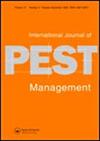乌拉圭不同生态系统中果蝇(双翅目:蝗科)及其宿主关联
IF 1.1
4区 农林科学
Q3 ENTOMOLOGY
引用次数: 0
摘要
摘要:乌拉圭缺乏对细纹无尾蠊和头状Ceratitis寄主组合的全面和系统的调查。我们的目的是确定乌拉圭农业生态系统和野生环境中不同水果物种在田间条件下的寄主地位和使用模式。使用四个PBX®酵母/硼砂颗粒引诱的McPhail诱捕器,在柑橘和落叶果园中进行了去甲福林监测。通过收集商业和非商业果园以及野生植被中的水果,对寄主水果进行了调查。Ceratis capitata和A.fraterculus是仅有的两种经济上重要的果蝇。Ceratis capita在与商业和干扰环境相关的柑橘林和落叶果园中普遍存在,而A.fraterculus主要与非商业水果和未受干扰的生态系统相关。在不同的寄主和生态系统中观察到的C.capitata和A.fraterculus丰度的差异可能与寄主关联、资源竞争、环境条件和寄生等因素有关。本文章由计算机程序翻译,如有差异,请以英文原文为准。
Fruit flies (Diptera: Tephritidae) and hosts association in different ecosystems in Uruguay
Abstract Thorough and systematic surveys of host associations of Anastrepha fraterculus and Ceratitis capitata are lacking in Uruguay. Our aim was to establish the host status in field conditions and the pattern of use of different fruit species in agroecosystems and wild environments in Uruguay. Tephritid monitoring was conducted in citrus and deciduous fruit orchards using McPhail traps baited with four PBX® yeast/borax pellets. A survey of host fruits was conducted by collecting fruits in commercial and non-commercial orchards and wild vegetation. Ceratitis capitata and A. fraterculus were the only two economically important fruit fly species recorded. Ceratitis capitata prevailed in citrus groves and deciduous fruit orchards associated with commercial and disturbed environments whereas A. fraterculus was associated mostly with non-commercial fruits and undisturbed ecosystems. The differences in abundance of C. capitata and A. fraterculus observed in different hosts and ecosystems may be related to factors such as host association, resource competition, environmental conditions and parasitism, among others that are discussed.
求助全文
通过发布文献求助,成功后即可免费获取论文全文。
去求助
来源期刊
CiteScore
4.70
自引率
6.70%
发文量
74
审稿时长
>12 weeks
期刊介绍:
International Journal of Pest Management publishes original research papers and reviews concerned with pest management in the broad sense, covering the control of pests (invertebrates, vertebrates and weeds) and diseases of plants, fungi and their products – including biological control, varietal and cultural control, chemical controland interference methods.
The management of invasive species is of special interest. We also encourage submissions dealing with interactions of multiple pests such as arthropods and plant pathogens, pathogens and weeds or weeds and arthropods as well as those dealing with the indirect and direct effects of climate change on sustainable agricultural practices.

 求助内容:
求助内容: 应助结果提醒方式:
应助结果提醒方式:


